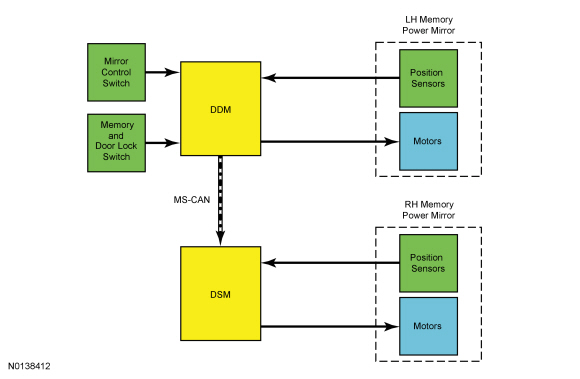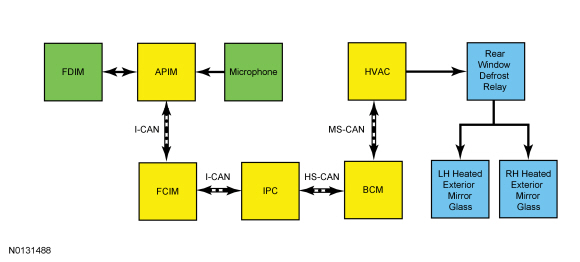SPECIFICATIONS
Torque Specifications

DESCRIPTION AND OPERATION
Rear View Mirrors
Exterior, Power
Overview
Power mirrors allow the LH and RH exterior mirror glass to be positioned electronically. The position of the power mirror glass is controlled by the exterior mirror control switch. Selecting the LH or RH button of the exterior mirror control switch determines which power mirror glass to control.
The LH and RH exterior mirrors may be equipped with approach or puddle lamps, which will illuminate when the interior lights are turned on by opening a door or by pressing the unlock button on the transmitter. Refer to Section 417-02.
The LH and RH exterior mirrors may be equipped with either a spotter mirror in the upper outboard corner of the exterior mirror glass or BLIS / CTA indicators. Refer to Section 419-04.
System Operation
The LH and RH exterior mirror glass movement is controlled by the exterior mirror control switch and the LH and RH exterior mirror motors. When the ignition is ON and the exterior mirror control switch button is pressed in the left, right, up or down position, voltage and ground is supplied by the switch to the appropriate exterior mirror motor to move the exterior mirror glass to the desired position.
Component Description
Exterior Mirror Control Switch
The exterior mirror control switch is integral to the master window control switch. The exterior mirror control switch provides the driver with the controls to move the LH and RH exterior rear view mirrors left, right, up or down. The buttons on the exterior mirror selection switch have a indicator to indicate which mirror is selected.
Exterior Mirror
Each exterior mirror is equipped with 2 bi-directional motors that are used to control the left/right and up/down positioning of the mirror glass. The exterior mirrors use a jumper harness between the vehicle wiring harness and the exterior mirror motors. The jumper harness in integral to the exterior mirror.
Exterior, Memory
Overview
The memory mirror function recalls the preferred positioning of the LH and RH exterior mirror glass. When a memory position is recalled by the operator, the LH and RH exterior mirror glass automatically adjusts to the preferred position stored in memory.
System Operation
System Diagram

Network Message Chart
Module Network Input Messages - DSM

LH and RH exterior mirror glass movement is controlled by the exterior mirror control switch, DDM, DSM and the LH and RH exterior mirror motors. The exterior mirror control switch sends voltage signals to the DDM. The DDM provides voltage and ground to the LH exterior mirror motors to move the LH exterior mirror glass to the desired position. When the RH exterior mirror is selected, the DDM sends the passenger mirror movement requests over the MS-CAN to the DSM. The DSM provides voltage and ground to the RH exterior mirror motors to move the RH exterior mirror glass to the desired position.
The memory function saves or recalls the preferred position of the exterior mirrors when the transmission is in PARK or NEUTRAL and the memory set switch, RKE transmitter (without IA ) or IA key (with IA ) is activated.
Component Description
Exterior Mirror Control Switch
The exterior mirror control switch is integral to the master window control switch. The exterior mirror control switch provides the driver with the controls to move the LH and RH exterior rear view mirrors left, right, up or down. The exterior mirror control switch also incorporates a selection buttons to determine which mirror will be controlled. The selection buttons have an indicator to show which exterior mirror is selected.
Memory Set Switch
The memory set switch allows the recall of previously stored positions for the driver. This system allows the preferred positioning of the driver seat and exterior rear view mirrors to be recalled or saved. The memory set switch is a momentary ground contact switch that supplies a ground to the DDM.
Driver Seat Module (DSM)
The DSM incorporates multiple functions into one module and offers diagnostics to easily locate and repair concerns affecting the subsystems that it controls. The DSM constantly tracks the RH exterior mirror motor position using potentiometers that are internal to the exterior mirror motors. When a memory position is recalled, the DSM supplies voltage and ground to the RH exterior mirror motor and monitors the potentiometer circuits. When the stored memory position is reached, the DSM removes the voltage and ground from the motors. If the exterior mirror control switch is operated during a memory recall, the DSM stops the recall and responds to the exterior mirror control switch command. The DSM is capable of setting DTCs for the RH memory mirror when a concern exists.
Driver Door Module (DDM)
The DDM incorporates multiple functions into one module and offers diagnostics to easily locate and repair concerns affecting the subsystems that it controls. The DDM constantly tracks the LH exterior mirror motor position using potentiometers that are internal to the exterior mirror motors. When a memory position is recalled, the DDM supplies voltage and ground to the LH exterior mirror motor and monitors the potentiometer circuits. When the stored memory position is reached, the DDM removes the voltage and ground from the motors. If the exterior mirror control switch is operated during a memory recall, the DDM stops the recall and responds to the exterior mirror control switch command. The DDM is capable of setting DTCs for the memory mirror system when a system concern exists.
Exterior Mirror
Each exterior mirror is equipped with 2 bi-directional motors that are used to control the left/right and up/down positioning of the mirror glass. Each exterior mirror motor has an integral potentiometer that is monitored by the DDM (LH mirror) or DSM (RH mirror) to determine the mirror position. The exterior mirrors use a jumper harness between the vehicle wiring harness and the exterior mirror motors. The jumper harness in integral to the exterior mirror.
Exterior, Heated
Overview
The exterior mirrors are available with optional heated mirror glass, which heats the mirror glass to remove frost, snow, ice and condensation. The rear window defrost system controls the operation of the heated exterior mirrors. The heated mirrors only operate when the rear window defrost is on.
System Operation
System Diagram

Network Message Chart
Module Network Input Messages - FCIM

Module Network Input Messages - HVAC Module

The rear window defrost system controls operation of the heated exterior mirror glass. The heated exterior mirror glass only operates when the rear window defrost system is active. The heated exterior rear view mirror glass deactivates when the rear window defrost deactivates. The heated mirror glass receives voltage from the rear window defrost relay located inside the BJB. The LH and RH heated mirror glass does not share the same ground.
Component Description
Heating Ventilation Air Conditioning (HVAC) Module
The HVAC module uses inputs generated by the vehicle occupants through the FCIM, FDIM and voice commands to control the climate system. The HVAC module is remotely located and separate from the control interfaces. When rear window defrost is selected, the FCIM, FDIM or voice command communicates through the I-CAN and the MS-CAN to the HVAC module to turn ON the defrost relay.
Exterior Mirror
The heated power exterior mirrors use a heating element that is integral to the exterior mirror glass.
Exterior, Auto-Dimming
Overview
The LH exterior mirror is equipped with an optional auto-dimming function that electronically darkens the LH exterior mirror glass when bright lights (glare) are detected from behind the vehicle during nighttime conditions. The LH exterior mirror auto-dimming function is controlled by the interior auto-dimming mirror.
System Operation
LH Exterior Auto-Dimming Mirror
When glare is detected from behind the vehicle during nighttime conditions, the interior auto-dimming mirror supplies voltage and ground to the LH exterior auto-dimming mirror to darken the glass. Refer to the Interior, Auto-Dimming description below for more information.
Component Description
Exterior Mirror
The electrochromatic function is integral to the LH exterior mirror glass. The exterior mirrors use a jumper harness between the vehicle wiring harness and the exterior mirror glass. The jumper harness is integral to the exterior mirror.
Interior Auto-Dimming Mirror
The interior auto-dimming mirror supplies voltage and ground to the LH exterior auto-dimming mirror glass to control the reflectance level.
Interior
Overview
The interior rear view mirror has pivot points which allow adjustment of the mirror up or down and from side to side. The interior mirror may be equipped with the manual dimming or auto-dimming feature. The manual dimming function is completely controlled by the driver. The auto-dimming function electronically darkens the interior and LH exterior mirror glass when bright lights (glare) are detected from behind the vehicle during nighttime conditions.
System Operation
Interior Rear View Mirror - Manual-Dimming
The manual dimming interior rear view mirror has a lever at the back of the mirror that must be pushed forward or pulled rearward by the driver to activate the manual dimming function. Manual dimming is completely controlled by the driver.
Interior Rear View Mirror - Auto-Dimming
The interior auto-dimming rear view mirror automatically reduces the glare caused by headlamps reflecting in the interior rear view mirror. Voltage is supplied to the interior auto-dimming mirror when the ignition is in ACC or ON. When the forward facing sensor detects daytime conditions, the rearward facing sensor is inactive and the mirror stays in a high reflectance mode. When the forward facing sensor detects nighttime conditions, the rearward facing sensor is active and detects glare from the headlights of vehicles approaching from the rear, or other glare producing light sources. To provide increased visibility when backing up, the interior rear view mirror automatically returns to a high reflectance mode whenever the vehicle is in REVERSE.
Component Description
Interior Rear View Mirror - Auto-Dimming
The auto-dimming rear view mirror has 2 photoelectric sensors, forward facing and rearward facing, that detect forward and rearward light conditions. Based on inputs from these sensors, the automatic dimming feature adjusts the reflectance level of the interior rear view mirror glass to eliminate unwanted glare. The reflectance level of the mirror glass is variable and depends on the amount of rear glare in relation to ambient light conditions in front of the interior mirror. If equipped, the IPM-A is integral to the interior rear view mirror.
 Diagnosis and Testing
Diagnosis and Testing
Rear View Mirrors - Exterior
DTC Chart(s)
Diagnostics in this manual assume a certain skill level and knowledge of
Ford-specific diagnostic practices. REFER to Section 100-00 for informatio ...
Other materials:
Ordering additional owner’s literature
To order the publications in this portfolio, contact Helm, Incorporated at:
HELM, INCORPORATED
47911 Halyard Drive
Plymouth, Michigan 48170
Attention: Customer Service
Or to order a free publication catalog, call toll free: 1-800-782-4356
Monday-Friday 8:00 a.m. - 6:00 p.m. EST
Helm, Incorpor ...
Driveline System - General Information
SPECIFICATIONS
Material
General Specifications
DESCRIPTION AND OPERATION
Driveline System
The driveline system consists of the following components:
Center support bearing
Driveshaft assembly
Front halfshafts
Rear halfshafts
Active Torque Coupling (ATC)/rear axle
On Front Wheel Drive (FWD ...
Center console
Stow items in the cupholder carefully as items may become loose during
hard braking, acceleration or collisions, including hot drinks which may
spill.
Note: The appearance and features of the center console may be
different than shown based on your vehicle’s option level.
Available consol ...

